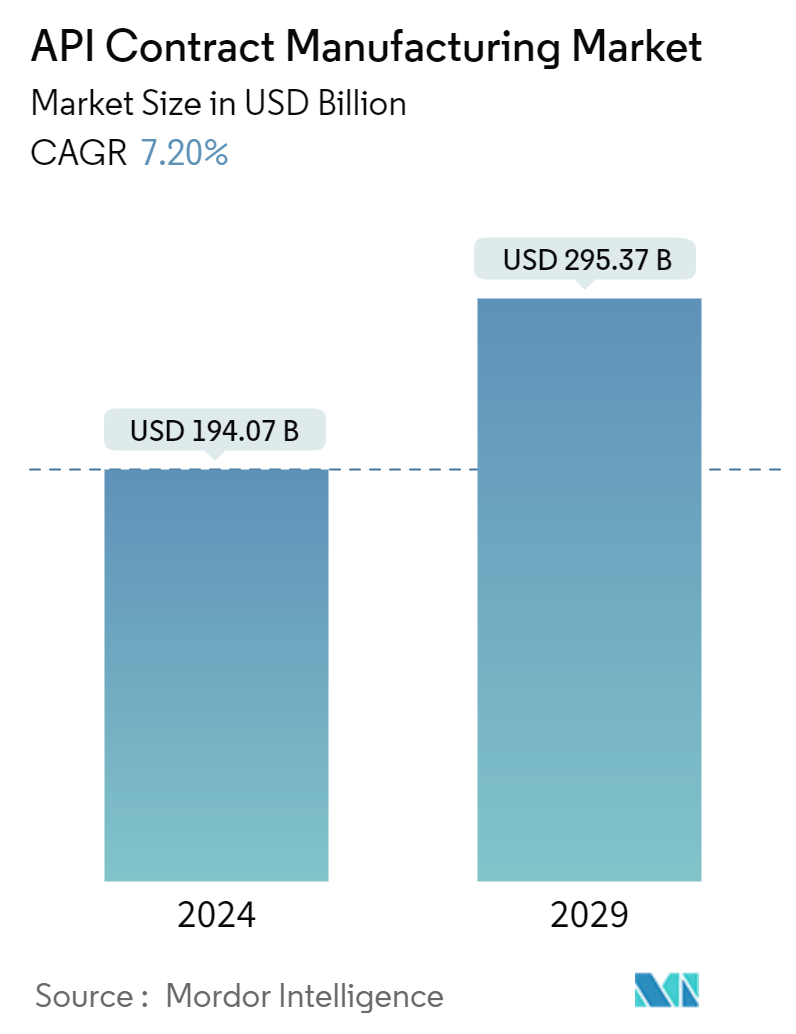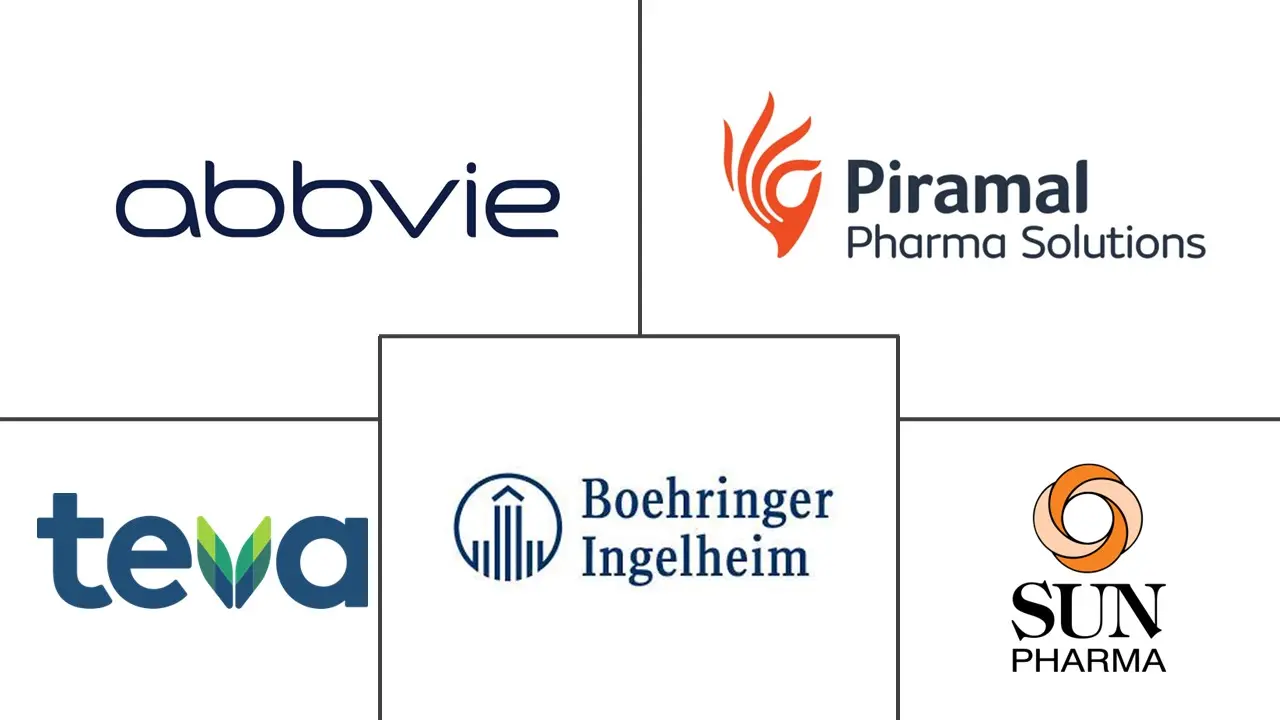Market Size of API Contract Manufacturing Industry

| Study Period | 2019 - 2029 |
| Market Size (2024) | USD 194.07 Billion |
| Market Size (2029) | USD 295.37 Billion |
| CAGR (2024 - 2029) | 7.20 % |
| Fastest Growing Market | North America |
| Largest Market | Asia Pacific |
Major Players
*Disclaimer: Major Players sorted in no particular order |
API Contract Manufacturing Market Analysis
The API Contract Manufacturing Market size is estimated at USD 194.07 billion in 2024, and is expected to reach USD 295.37 billion by 2029, growing at a CAGR of 7.20% during the forecast period (2024-2029).
Growing demand for API contract manufacturing services drives the industry's growth as companies seek to benefit from cost savings and increased efficiency. Also, the installation and maintenance of the facility is complex and requires specialized engineers. The high cost of producing API in-house and the pressure to deliver affordable drugs have significantly contributed to companies' increasing outsourcing activities. There are various reasons why the demand for specific markets will increase. For instance, companies recognize the importance of focusing on their main activities, such as research and development, marketing, and regulatory compliance. In addition, there is a need to reduce the time it takes for drugs to be developed and launched in the market. These factors are expected to create profitable growth opportunities for the target market.
The increasing development and clinical trials of biosimilar and biologics drugs for new therapeutic classes are expected to increase their adoption by physicians and patients. This is anticipated to increase the demand for APIs, propelling the market's growth. As per Cardinal Health’s 2022 Biosimilars Report, significant progress has been made in the adoption of biosimilars in the United States, particularly in oncology, where all three classes of therapeutic oncology biosimilars (i.e., rituximab, bevacizumab, and trastuzumab) have exceeded 60% market share.
Similarly, as per the same source, as of January 2022, there were 33 FDA-approved biosimilars in the United States, of which 21 are commercially available. Of the 21 biosimilars, 17 are used for treatments associated with cancers, three are used to treat autoimmune conditions, and one is used to treat diabetes. Thus, increasing demand for biosimilar and biologics drugs will create lucrative market growth opportunities during the forecast period.
The strategic activities of the market players, such as expansion of the API facilities, partnership, and collaboration, are expected to boost market growth during the forecast period. For instance, in April 2022, Cambrex completed a USD 50 million expansion of its large-scale API manufacturing capabilities at its Charles City, Iowa, facility. The facility is located on a 45-acre property and produces APIs and pharmaceutical intermediates, including highly potent molecules and controlled substances. Additionally, in January 2022, Formosa Laboratories, a Taoyuan, Taiwan-based CDMO of APIs, ADCs, and injectables, invested USD 20 million to expand its API manufacturing facility to build up its bioconjugation ADC platform, a peptide-generation system for personalized medicine production and a microfluidic synthesis system at its facility in Taiwan.
Hence, increasing outsourcing of API manufacturing, the growing burden of chronic diseases, and market players' strategic activities are expected to boost market growth during the forecast period. However, intellectual property concerns and stringent regulatory guidelines are expected to restrain market growth during the forecast period.
API Contract Manufacturing Industry Segmentation
API contract manufacturing market is segmented by type, form, molecules, manufacturing, end users, and geography. By type, the market is segmented as organic and inorganic. The market is segmented by form as solid, liquid, and semi-solids. The market is segmented by molecules as small molecules API and large molecules API. By manufacturing, the market is segmented into clinical and commercial manufacturing. The market is segmented by end users, such as pharmaceutical industries, research organizations, and other end users. By geography, the market is segmented as North America, Europe, Asia-Pacific, Middle East and Africa, and South America. The report also covers the estimated market sizes and trends for 17 countries across major regions globally. The report offers the value (in USD) for the above segments.
| By Type | |
| Organic | |
| Inorganic |
| By Formulation | |
| Solid | |
| Liquid | |
| Semi-solid |
| By Molecule | |
| Small Molecule API | |
| Large Molecule API |
| By Manufacturing | |
| Clinical Manufacturing | |
| Commercial Manufacturing |
| End User | |
| Pharmaceutical and Biotechnology Companies | |
| Research Organization | |
| Other End Users |
| Geography | ||||||||
| ||||||||
| ||||||||
| ||||||||
| ||||||||
|
API Contract Manufacturing Market Size Summary
The API contract manufacturing market is poised for significant growth, driven by the increasing demand for cost-effective and efficient manufacturing solutions in the pharmaceutical industry. Companies are increasingly outsourcing API production to focus on core activities such as research and development, marketing, and regulatory compliance. This trend is further fueled by the complex and specialized nature of in-house manufacturing facilities, which require significant investment and expertise. The rising prevalence of chronic diseases, particularly cancer, is also contributing to market expansion, as tailored therapies necessitate sophisticated APIs. Strategic activities by market players, including facility expansions and partnerships, are expected to further bolster market growth during the forecast period.
The Asia-Pacific region is emerging as a key player in the API contract manufacturing market, with countries like India and China offering cost-effective solutions and robust manufacturing capabilities. The region's appeal is enhanced by government investments and the increasing production of generic pharmaceuticals. The market is characterized by fragmentation, with numerous global and regional players vying for market share. Companies are focusing on expanding their manufacturing facilities and enhancing production capabilities to meet the growing demand. Despite challenges such as intellectual property concerns and stringent regulatory guidelines, the market is expected to experience substantial growth, supported by favorable regulations and strategic initiatives by contract manufacturing organizations.
API Contract Manufacturing Market Size - Table of Contents
-
1. MARKET DYNAMICS
-
1.1 Market Overview
-
1.2 Market Drivers
-
1.2.1 Growing Demand for Generic Medicines Due to Patent Expirations
-
1.2.2 Increasing Trend of Outsourcing for API
-
1.2.3 Growing Demand for Generic Medicines Due to Patent Expirations
-
-
1.3 Market Restraints
-
1.3.1 Intellectual Property Concern
-
1.3.2 Stringent Regulatory Requirements
-
-
1.4 Porter's Five Forces Analysis
-
1.4.1 Bargaining Power of Suppliers
-
1.4.2 Bargaining Power of Buyers/Consumers
-
1.4.3 Threat of New Entrants
-
1.4.4 Threat of Substitute Products
-
1.4.5 Intensity of Competitive Rivalry
-
-
-
2. MARKET SEGMENTATION (Market Size by Value – USD)
-
2.1 By Type
-
2.1.1 Organic
-
2.1.2 Inorganic
-
-
2.2 By Formulation
-
2.2.1 Solid
-
2.2.2 Liquid
-
2.2.3 Semi-solid
-
-
2.3 By Molecule
-
2.3.1 Small Molecule API
-
2.3.2 Large Molecule API
-
-
2.4 By Manufacturing
-
2.4.1 Clinical Manufacturing
-
2.4.2 Commercial Manufacturing
-
-
2.5 End User
-
2.5.1 Pharmaceutical and Biotechnology Companies
-
2.5.2 Research Organization
-
2.5.3 Other End Users
-
-
2.6 Geography
-
2.6.1 North America
-
2.6.1.1 United States
-
2.6.1.2 Canada
-
2.6.1.3 Mexico
-
-
2.6.2 Europe
-
2.6.2.1 United Kingdom
-
2.6.2.2 Germany
-
2.6.2.3 France
-
2.6.2.4 Spain
-
2.6.2.5 Italy
-
2.6.2.6 Rest of Europe
-
-
2.6.3 Asia-Pacific
-
2.6.3.1 India
-
2.6.3.2 Japan
-
2.6.3.3 China
-
2.6.3.4 Australia
-
2.6.3.5 South Korea
-
2.6.3.6 Rest of Asia-Pacific
-
-
2.6.4 Middle East and Africa
-
2.6.4.1 GCC
-
2.6.4.2 South Africa
-
2.6.4.3 Rest of the Middle East and Africa
-
-
2.6.5 South America
-
2.6.5.1 Brazil
-
2.6.5.2 Argentina
-
2.6.5.3 Rest of South America
-
-
-
API Contract Manufacturing Market Size FAQs
How big is the API Contract Manufacturing Market?
The API Contract Manufacturing Market size is expected to reach USD 194.07 billion in 2024 and grow at a CAGR of 7.20% to reach USD 295.37 billion by 2029.
What is the current API Contract Manufacturing Market size?
In 2024, the API Contract Manufacturing Market size is expected to reach USD 194.07 billion.

